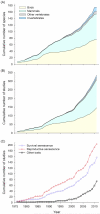Senescence in natural populations of animals: widespread evidence and its implications for bio-gerontology
- PMID: 22884974
- PMCID: PMC4246505
- DOI: 10.1016/j.arr.2012.07.004
Senescence in natural populations of animals: widespread evidence and its implications for bio-gerontology
Abstract
That senescence is rarely, if ever, observed in natural populations is an oft-quoted fallacy within bio-gerontology. We identify the roots of this fallacy in the otherwise seminal works of Medawar and Comfort, and explain that under antagonistic pleiotropy or disposable soma explanations for the evolution of senescence there is no reason why senescence cannot evolve to be manifest within the life expectancies of wild organisms. The recent emergence of long-term field studies presents irrefutable evidence that senescence is commonly detected in nature. We found such evidence in 175 different animal species from 340 separate studies. Although the bulk of this evidence comes from birds and mammals, we also found evidence for senescence in other vertebrates and insects. We describe how high-quality longitudinal field data allow us to test evolutionary explanations for differences in senescence between the sexes and among traits and individuals. Recent studies indicate that genes, prior environment and investment in growth and reproduction influence aging rates in the wild. We argue that - with the fallacy that wild animals do not senesce finally dead and buried - collaborations between bio-gerontologists and field biologists can begin to test the ecological generality of purportedly 'public' mechanisms regulating aging in laboratory models.
Copyright © 2012 Elsevier B.V. All rights reserved.
Figures


References
-
- Abrams PA, Ludwig D. Optimality theory, gompertz' law, and the disposable soma theory of senescence. Evolution. 1995;49:1055–1066. - PubMed
-
- Altwegg R, Schaub M, Roulin A. Age-specific fitness components and their temporal variation in the barn owl. American Naturalist. 2007;169:47–61. - PubMed
-
- Andersson M. Sexual selection. Princeton University Press; Princeton: 1994.
-
- Auld JR, Charmantier A. Life history of breeding partners alters age-related changes of reproductive traits in a natural population of blue tits. Oikos. 2011;120:1129–1138.
Publication types
MeSH terms
Grants and funding
LinkOut - more resources
Full Text Sources
Other Literature Sources
Medical

